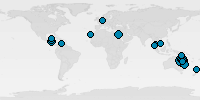3.64

Florida Mangroves is the best known mangrove forest dive site inside Biscayne Bay, Florida Keys.
| Name Dive Site: | Florida Mangroves |
| Depth: | 0-9ft (0-3m) |
| Accessibility: | Shore, Boat |
| Inserted/Added by: | lars, © Author: Lars Hemel |
| Rated: | Rated not yet |
| Specifications: |     |
Send us your images for this dive site[Add Image][Add Movie]
Biscayne National Park, but also other area's around the coast of Florida, has a tropical climate that is the perfect location for mangroves. Florida Mangroves is one of the many places we have chosen to mark on the map as it is one of the best known mangrove dive sites around the Keys, but remember that there are many others. Mangroves or mangal are found in shallow high nutrient coastal area's protected from heavy wave action. Its roots serve as food source for birds such as herons, egrets and frigate birds.
Mangrove trunks, tunnels, alley ways and many small overhangs create a very healthy and nutrient area full of fish and marine mammals. Many of them are known to divers from diving at all the different dive sites at the Florida Keys, but some are also particularly common in mangrove forests. Animal species such as the manatee will provide an extra underwater encounter you won't often see in other regions around the world. Also crocodiles and rattle snakes have known to live near mangroves although we think you have to be quite lucky if you encounter one underwater. Snooks, mangrove snappers and channel bass are some of the larger species known to live and breed inside its trunk habitat.
Some notes that appear to diving in mangroves are the following:
- Try to move around by pulling yourself along the roots of the mangroves. Most mangrove forests are heavily silted and very shallow, which are perfect conditions for many divers to kick up silt with their fins.
- Always carry a dive flag around your belly as most mangrove forests are heavy travelled by boats and other tourists. And you don't want to get hit by a boat engine while playing with a manatee.
- Pay special attention to maintaining your buoyancy as this is often difficult in shallow areas with some surge.
[Add Message]Messages from readers:
[Add Divelog]Divelogs from members:
